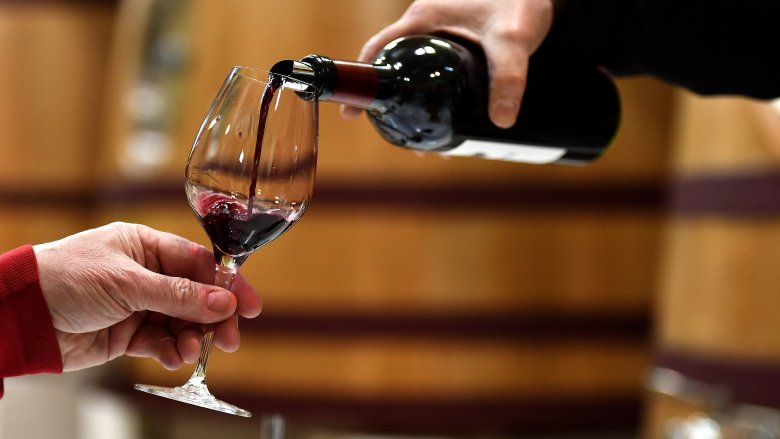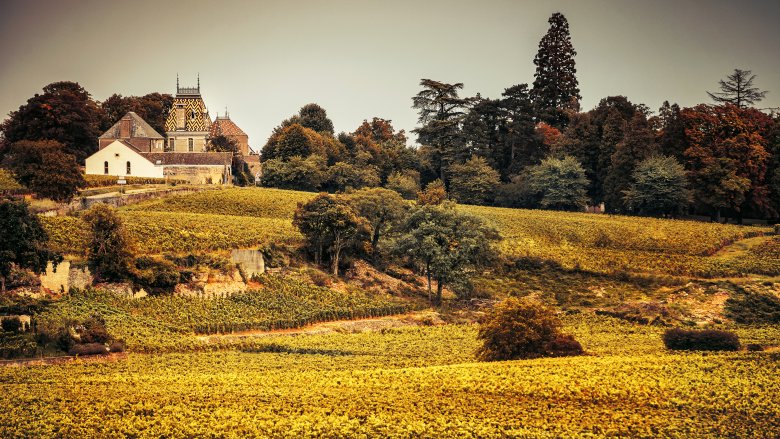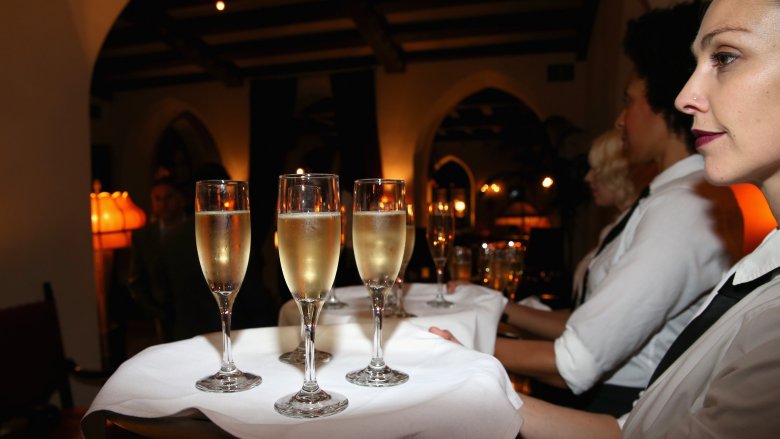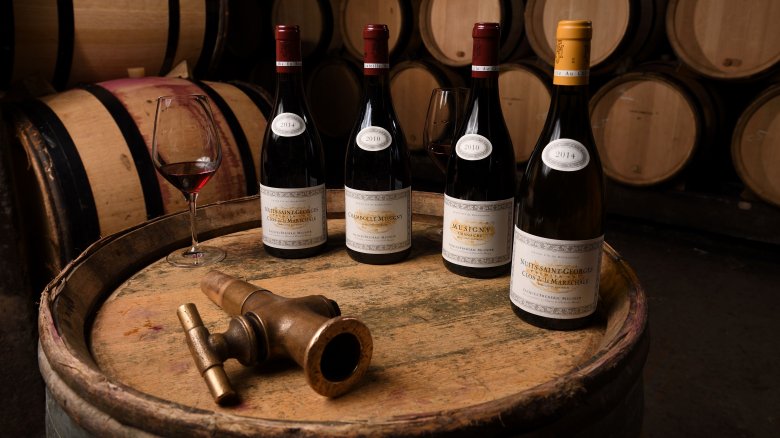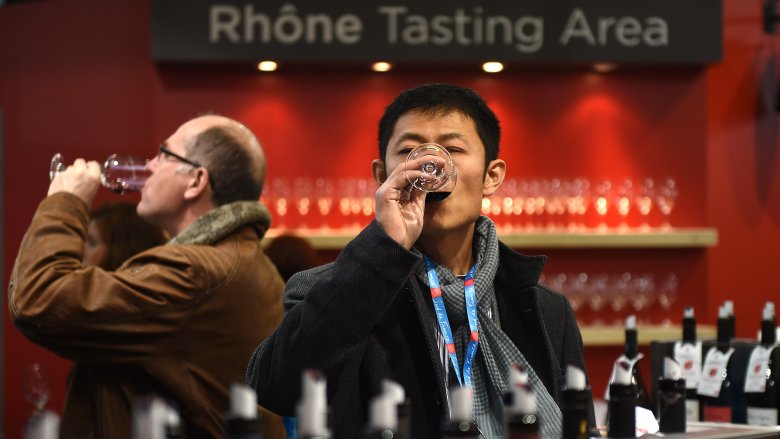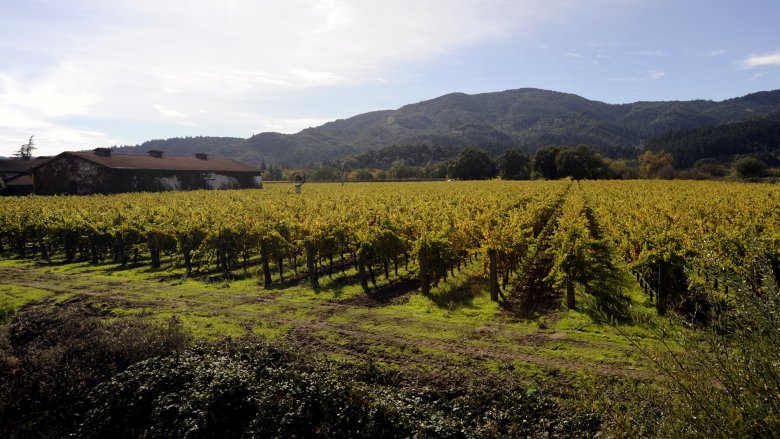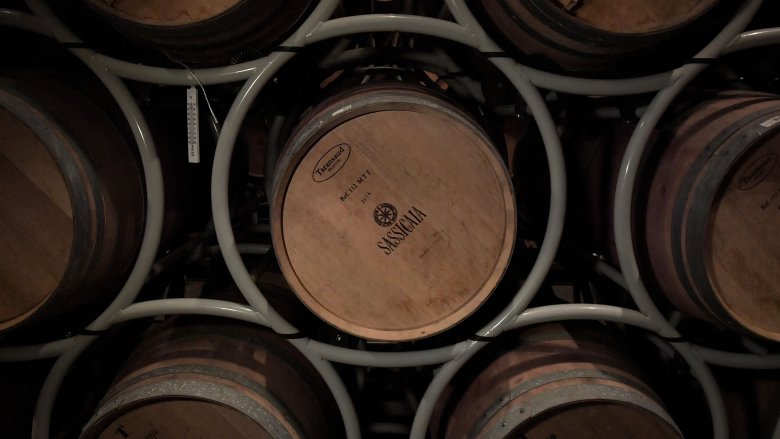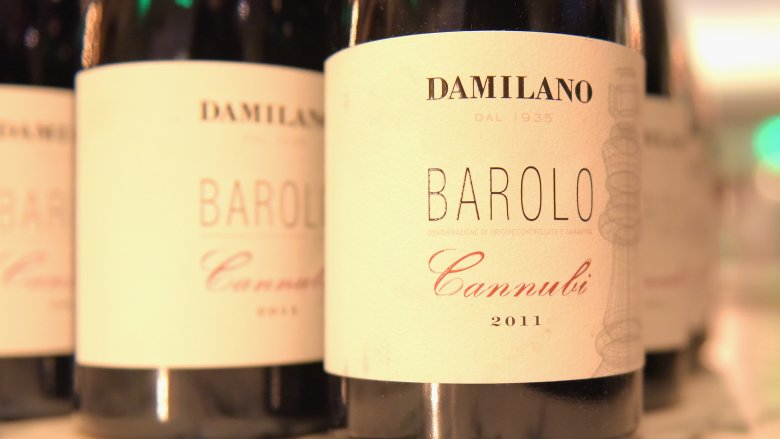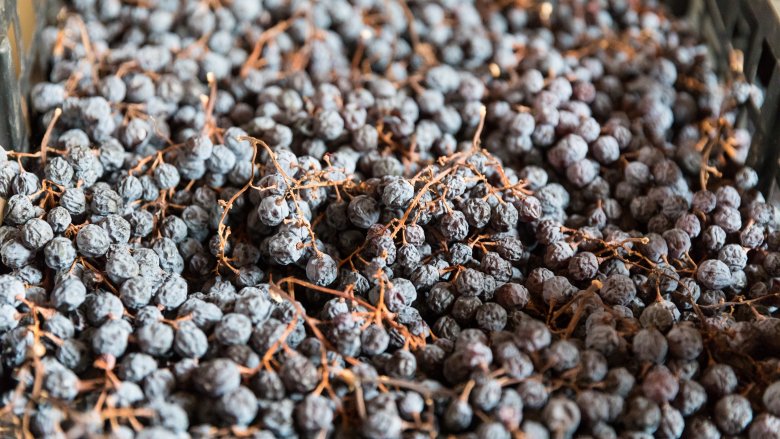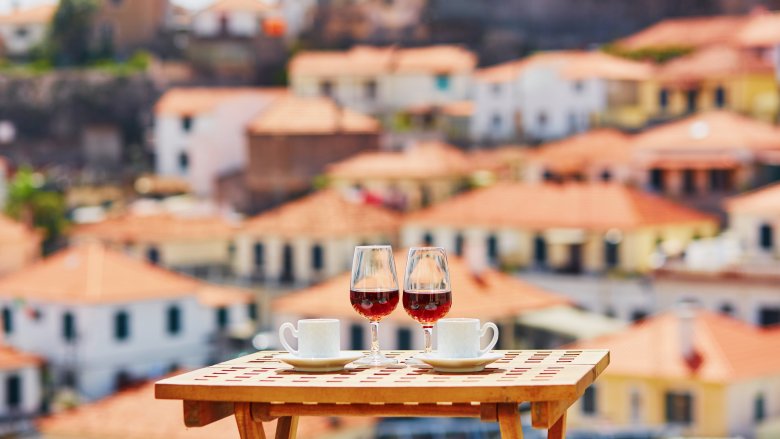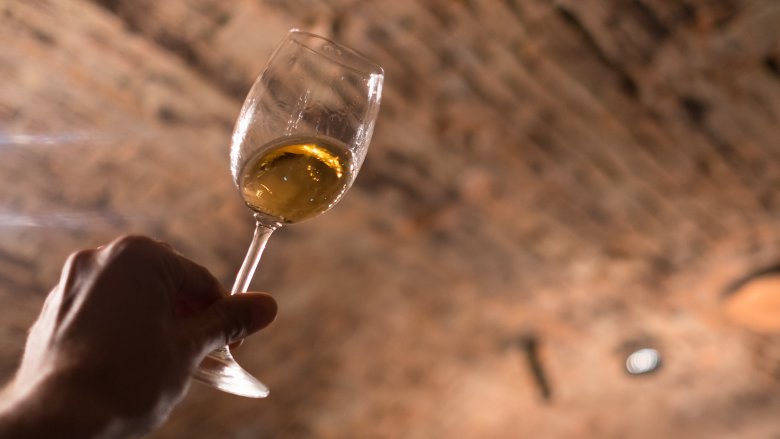The Most Expensive Wines You Should Try At Least Once
Thirsting for wine knowledge? Here's the good news: In the interest of education, most experts would agree, there isn't a bottle in the world you shouldn't try at least once. Even your average porch pounder affords the opportunity to sniff, swirl, sip, and analyze what you've just sniffed and sipped with an eye toward a greater understanding of the grape.
Here's the bad news: If you seek not mere sensory training but heavens-opening, angels-singing vinous enlightenment, you will inevitably have to cough up the big bucks. (We're talking $100 and up — way up — with some exceptions in the $50–90 range that might get you as far as the outskirts of nirvana, if not quite to the main square.) The following wines aren't the only world-class investments you could make to that end; some German Rieslings, Spanish Tempranillos, and Australian Shirazes, for example, can also hit the heights of both quality and price. But you've got to start the bucket list somewhere.
Burgundy
Ask wine experts what the single greatest grape-growing region in the world is, and nine out of 10 are sure to name Burgundy. Home to numerous famed districts, including the Côte d'Or and Chablis, that are in turn home to dozens of prized appellations (legally designated, quality-controlled production zones) that are each home to hundreds of historic vineyards or crus, it's a perfect example of viticulture, as the science of vine cultivation is called. (Yes, we're throwing a lot of terminology at you. We trust you can keep up.)
As simply defined by VinePair, "terroir is a sense of place," determined by such factors as soil type, climate, and topography (which covers altitude, sun exposure, and so on). If you were to compare two Pinot Noirs made exactly the same way at the same time in two different places, they would taste different due to terroir.
Speaking of Pinot Noir, that's what red Burgundy is, by definition. White Burgundy is Chardonnay. Sounds simple — but the crème de la crème, coming from, say, Gevrey-Chambertin or Meursault, is anything but, coveted for its complexity, longevity, and, of course, rarity. The most legendary estates, such as Domaine de la Romanée-Conti, make tiny amounts of wine from tiny plots of land as unique as they are priceless. Such is the law of supply and demand: In 2017, seven of the 10 most expensive bottles of wine in the world were Burgundies.
Champagne
Bubbly is a process, not a place; superb versions are produced all over the globe, from the Franciacorta appellation in the northern Italian region of Lombardy, to New Mexico, to England. But only one place has remained synonymous with sparkling wine for centuries: Champagne.
Pinot Noir and Chardonnay predominate here, supplemented by Pinot Meunier (along, sometimes, with trace amounts of a few other permitted grapes). As in Burgundy, terroir matters: The cool climate in this part of northern France dictates Champagne's fresh acidity, the chalky soils its fine minerality. And as with Burgundy, the good stuff is gonna cost you. In Champagne, however, high price isn't necessarily a reflection of limited yield: after all, the best-known luxury houses, such as Krug and Moët & Chandon, produce hundreds of thousands of bottles annually. More to the point is the method of production, which is extremely time- and labor-intensive. (You didn't think Champagne was simply carbonated like soda pop, did you?)
Of course, you may also also paying for name recognition: There's prestige in popping the cork on a magnum of Dom Pérignon or Cristal. Conversely, there's great value to be found in "farmer fizz," to use the cheeky term for bubbly made by the grape grower, rather than by a négociant or purchaser, as is common here. But with its rise in status, even grower Champagne can now fetch three figures. So be it — it's only fitting that the price of drinking stars would be astronomical.
Bordeaux
Is Bordeaux worth the vast sums some collectors are willing to pay on mere speculation? That depends on whom you ask; as Hugh Johnson and Jancis Robinson write in The World Atlas of Wine, "fine Bordeaux has, regrettably, become a trading commodity" in the form of futures, or purchases of wine still in barrel. A hyped vintage can yield four-figure asking fees per bottle.
Blame Napoleon, who got the ball rolling back in 1855 when he commissioned a ranking of the top châteaux in this western region of France. The resulting classification has held up surprisingly well, as the five so-called First Growths — Lafite-Rothschild, Mouton-Rothschild, Latour, Margaux, and Haut-Brion — still take top slots in regional price rankings. They're all located on Bordeaux's Left Bank, venerated for its Cabernet Sauvignon–based red blends. Also on the Left Bank is Sauternes, which received special mention for its exceptional sweet white wines (primarily blends of Sémillon and Sauvignon Blanc); their reputation, exemplified by Château d'Yquem, is still unparalleled. But many Second Growths also command pretty pennies today, as do many relative upstarts from the Right Bank — most notably Le Pin and Pétrus — where Merlot takes center stage.
In any case, at their best, the châteaux of Bordeaux are in Johnson and Robinson's words "the world's archetypes for blends of Cabernet and Merlot."
Rhône Valley wines
Especially compared to the aforementioned regions, there are great bargains to be found across this southwestern stretch of France. Then again, if it's a bargain you want, you're reading the wrong article. So let's get straight to the superlatives.
Though it also includes some mighty fine whites made from Viognier, Northern Rhône wine does its best work through the Syrah (or Shiraz). Here, two appellations in particular have the reputations to show for their price tags. One is Côte-Rôtie, where the steep terrain both curtails and complicates vine cultivation: Low production plus high effort equals dollar signs. But it also yields a profound sensory experience, apparent in this wine writer's words of "black raspberry, black currant, violet, and chocolate along with savory hints of olive, bacon fat, white pepper, and powerful charcoal smoke." (Sounds pretty good, right?) The other is the even-smaller Hermitage, which builds its big, heady Syrahs to last for decades; in fact, they're not even ready to drink until years after their release, according to the Wine Cellar Insider. Low production plus long life also equals dollar signs.
Meanwhile, the star of the Southern Rhône is Châteauneuf-du-Pape — a Grenache-dominant red blend boasting its own eclectic profile of dark fruit, meat, earth, spices, and herbs as well as what critic Robert Parker calls a "rich and round, sumptuous and opulent" texture that's "virtually unmatched by most of the wines in the world." And yep, you bet high praise from Parker equals dollar signs too.
Napa Valley Cabernet
God bless America, where freedom rings and appellation regulations are as lax as Europe's are strict. Take its most famous American viticultural area, the Napa Valley: So long as 85 percent of their grapes are grown within its boundaries, winemakers here can showcase any varietals they please, using any techniques, and still put Napa on the label.
But Cabernet Sauvignon, along with Chardonnay, has been its calling card ever since the Judgment of Paris — the storied 1976 tasting competition that saw two varietal wines from California outperform their French counterparts in an upset so dramatic it inspired a 2008 feature film, Bottle Shock. The winning red producer, Stag's Leap Wine Cellars, remains a giant among dozens of Napa luxury estates that today make miniscule amounts of Cabernet Sauvignon in exchange for staggering heaps of cash.
In the 1990s, some of them began capitalizing further on the law of supply and demand by circumventing the distribution chain and limiting sales almost exclusively to mailing-list subscribers and restaurant buyers. The ploy worked, generating permanent hype for the wines now known as Napa's "cult cabs." Made by such pioneers as Screaming Eagle, Harlan Estate, and Colgin Cellars as well as newer brands like Hundred Acre, Scarecrow, and Dana Estates, they range in style from fruit-forward extravagance to terroir-driven finesse — and in price from the eye-popping to the jaw-dropping (despite occasional predictions of market devaluation). So your best bet for acquiring any is to start making friends in high places.
Super Tuscans
Super Tuscans may sound like Italian comic-book heroes, but they're simply red wines that, back in the 1970s, didn't meet the requirements for appellation status in their namesake region of Italy. Their earliest champions, however, are viewed as superheroes indeed for breaking industry rules that, most now agree, needed breaking.
While their California brethren were attracting notice for their freewheeling ways, these visionaries had begun to feel so hamstrung by the regulations of Chianti production that they decided they were better off declassifying their wine. They would make it with the grapes they chose, where they chose — even if that meant branding it with the scarlet letter that was the lowly vino da tavola label designation.
As Wine Enthusiast's Monica Larner explains, the results were game-changing. In fact, they were law-changing. With brands such as Tinganello, Sassicaia, Solaia, and Ornellaia — all Bordeaux-inspired blends, some incorporating the traditional Sangiovese — receiving international acclaim, the government eventually revamped the classification system to account for their likes.
Unfortunately, some less-scrupulous (and/or less-talented) producers took advantage of the relaxed guidelines to release "Super Tuscans" that were really sub Tuscans, which brings us to the moral of the story: Ask a trusted retailer or sommelier for recommendations. These days, the best "Super Tuscans" might actually be appellation wines such as Bolgheri or Suvereto — or even Chianti Classicos that, under the old guidelines, would have been declassified.
Barolo
As none other than bad-boy fiction writer–turned–wine critic Jay McInerney recently described this appellation in the northern Italian region of Piedmont, "Barolo delivers everything we ask of a great wine. It has impressive longevity and complexity, and it is utterly distinct, speaking inimitably of the place from which it comes, with a unique combination of flavors and aromas: tar, rose, licorice, and, yes, truffle," (the latter being a specialty of the Piedmontese town of Alba). What more ringing endorsement do you need?
The answer is not a one, but just in case: This here is some killer grape juice, made of 100 percent Nebbiolo, a red grape that Johnson and Robinson call Italy's "answer to Pinot Noir. ... When fully ripe it is exceptionally high in tannins and acids" that mellow over time to "result in hauntingly seductive wines." This map provides a handy guide to Barolo's various subzones and their celebrated vineyards. As it shows, you'd do well to choose wines from, say, La Morra if your tastes tend toward the charmingly fragrant and lithe, from Serralunga d'Alba or Monforte d'Alba if you're swayed by grip and vigor.
By the way, Barbaresco — Piedmont's other claim to Nebbiolo fame — runs a close second to Barolo in terms of both excellence and expense. But to experience what the Italians mean by a true vino da meditazione ("wine of contemplation"), Barolo is the only way to go.
Amarone della Valpolicella
From the home of Romeo and Juliet, Verona, comes a wine that exudes romance — and not just because its name resembles the Italian word for love, amore. Actually, amarone loosely translates to "bitter." But this red wine made from Corvina, Rondinella, Molinara, and other local varieties is so far from bitter as to be unabashedly sensuous. As Eater explains, Amarones are "rich, full-bodied, frequently high-alcohol wines with very unique, raisinated characters." They come by that raisin-like savor honestly, as the grapes that go into them are — you guessed it — partly dried.
The drying process, called appassimento, takes time, and time is money. So is decreased volume: You need a lot more shriveled grapes than ripe ones to make the same amount of wine. But there may be no better investment for wine novices: Because Amarone is anything but subtle, conveying sweetness while remaining dry, it's perhaps easier to understand and appreciate than many of the other entries on this list, making for a fine stepping stone to their more challenging pleasures.
Madeira
Named for the magical Portuguese island on which it's made, this fortified wine runs the gamut of styles and price points. It can be made from a blend of grapes or a single variety, harvested in different years or a single year (that is, nonvintage or vintage). It can serve as a relatively dry apéritif or a sweet treat for dessert. And it can be downright cheap — or run you thousands of dollars a pop.
In the latter case, the exorbitance reflects the fact that "Madeira wines, thanks to their high sugar content and their oxidative aging, are probably ... the most ageworthy wines on this earth," per Wine Searcher — which sells some that date back centuries. Of course, bottles that old are by definition rare, another determinant of worth.
But any single-varietal, vintage Madeira warrants a splurge. Depending on the grape used — from the driest, most invigorating Sercial through the intermediate Verdelho and Bual to the richest, sweetest Malvasia — it exhibits a wealth of aromas and flavors that range from citrus and smoke to dried fruits and nuts to caramel and chocolate, all in remarkable balance. And hey, if it was good enough for our founding fathers, it's good enough for you.
Tokaji Aszú
Like Sauternes (see: Bordeaux), this Hungarian sweet wine has had associations with nobility throughout history — and we're not just talking about the classes who drank it. We're also talking about the grapes that go into it, mainly Furmint and Hárslevelü, which are prone to a disease called noble rot.
That may sound like something that should come at a deep discount rather than a premium, but Botrytis cinerea (to use the scientific name of the fungus) actually concentrates the sugars in the affected berries, which must be picked by hand, as Wine Enthusiast explains. The more botrytized content in the final product, the sweeter — and, of course, pricier — it is.
Tokaji Aszú of at least six puttonyos tends toward the "ambrosial," says The New York Times' Eric Asimov, combining notes of ripe and preserved yellow stone fruit with flowers and honey. But an even sweeter version, called Eszencia, exists. Because it's "almost excruciatingly intense, wildly expensive, and rarely seen," in Asimov's words, you can't just pick it up at your local bottle shop on a whim. But you can occasionally find it at special-occasion restaurants like Frasca Food and Wine in Boulder, Colorado, where it's served per tradition by the crystal spoonful for $54 — practically a steal.
